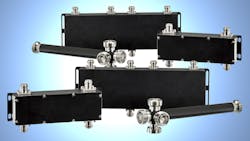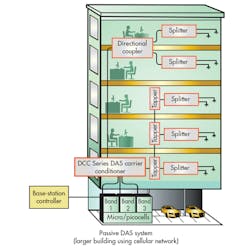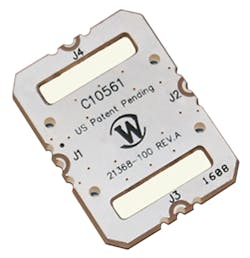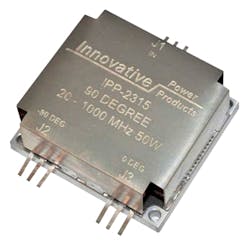Passive Components Punch Through Walls
This file type includes high-resolution graphics and schematics when applicable.
High-frequency passive components may lack the glamour of their active counterparts, but they play crucial roles when trying to meet system performance requirements. Such components, which include power dividers/combiners, directional couplers, hybrid couplers, and more, are needed to enable critical functionality for numerous applications. A distributed antenna system (DAS), for instance, relies heavily on high-performance passive components.
In addition, some suppliers offer passive components with superior power-handling capability to support high-power applications. This article takes a look at some of these passive-component solutions designed to meet these demanding requirements.
Distributed Antenna Systems
A DAS uses a network of antennas connected to a common location to provide wireless coverage to a specific area (Fig. 1). As a result, wireless coverage and capacity can be enhanced in areas that need a boost in service. A DAS can be deployed indoors or outdoors; settings include office buildings, convention centers, subways, airports, sports arenas, etc.
Passive components are an extremely important aspect of a DAS. For instance, power dividers and directional couplers allow signals to be distributed as required by the DAS. Because such a system may incorporate numerous passive components in its architecture, it’s important they provide adequate performance to satisfy the demands of the entire system.
Passive intermodulation (PIM) can occur due to the nonlinear mixing of two or more frequencies in a passive component, such as a cable, connector, or power divider. Causes of PIM include ferromagnetic materials, corrosion, and loose connections.
PIM can degrade the performance and reliability of a DAS. Specifically, unwanted intermodulation products generated by multiple signals in the downlink may appear in the uplink, thereby reducing quality of service. Thus, to help ensure reliable DAS performance, its passive components must have superior PIM characteristics.
One company focused on DAS applications is Radio Frequency Systems (RFS). “Growing demand for reliable wireless communications wherever people go, at all times, is driving network improvements to provide connectivity in even the most challenging environments,” says Eileen Januszkiewicz, commercial product manager of cables at RFS. “These environments include stadiums, airports, metro transportation systems, and hotels. The world will be watching the upcoming Summer Olympics, which will require unprecedented coverage capacity for millions of athletes, vendors, event managers, and spectators.”
Januszkiewicz adds, “Meeting communication needs in such venues requires cutting-edge infrastructure solutions. Passive DAS systems and components provide the flexibility for multi-band, multi-technology, multi-operator support. A single passive DAS solution can be shared by several operators delivering different wireless services using different technologies and frequency bands, including mission-critical (380-520 MHz), commercial wireless (698-2700 MHz), and broadband and ultra-broadband (380-2700 MHz) in 2G, 3G, 4G LTE, and TETRA.”
RFS has already delivered several DAS solutions, including its deployment of a passive DAS for the 2014 FIFA World Cup. Januszkiewicz explains, “RFS deployed a passive DAS solution that enabled wireless connectivity at four stadiums for the 2014 FIFA World Cup in Rio de Janeiro. The sophisticated, multi-operator solution used a new RF sectoring concept for each network, delivering a considerable increase in capacity when processing calls and ensuring 2G, 3G, 4G (LTE), and iDEN wireless communications throughout the venue for customers of five Brazilian operators. The networks were built with state-of-the-art indoor wireless infrastructure, including RF corrugated coaxial cables, RFS’s HYBRIFLEX hybrid cable, indoor and outdoor antennas, jumpers, and accessories.”
2. These components, which include couplers, tappers, power splitters, and hybrid combiners, are intended for DAS applications. (Courtesy of Radio Frequency Systems) (Click image to enlarge)
Earlier this year, the company unveiled a range of new passive RF components for DAS applications (Fig. 2). These products are intended to satisfy wireless in-building commercial and mission-critical communications requirements.
“RFS recently expanded its product portfolio of passive components,” says Januszkiewicz. “These components include couplers, power splitters, tappers, and hybrid combiners, complementing our comprehensive line of low-loss RF feeder cables and jumpers for DAS to help customers deploy future-proof solutions. All our passive DAS products share harmonized PIM specifications (–161 dBc) to maintain a high level of repeatability and reliability of services.”
Many other companies offer passive components for DAS applications. Among them is Microlab (which is part of the Wireless Telecom Group), which offers a variety of passive components such as tappers, power splitters, and directional couplers.
R&D Microwaves maintains its own line of DAS passive components. Covering a frequency range of 380 to 2700 MHz, these products include tappers, hybrids, and dividers/combiners. In addition, the company offers these components with different connector options, such as Type-N and 7/16 DIN.
For its part, Werlatone supplies a range of DAS-targeted passive components, which includes even and uneven splitters, unidirectional couplers, and dual directional couplers. All ports of non-isolated even and uneven splitters can communicate with one another. These components allow users to split a single run of a 50-Ω coaxial cable that simultaneously carries multiple service bands. By utilizing non-isolated even power splitters, one signal can be evenly split into two, three, or four signals, which can then enter corridors, tunnels, shafts, or rooms. Uneven splitters can be utilized to unevenly split a signal so that a shorter corridor, tunnel, shaft, or hallway is provided with a smaller portion of the power on the main coaxial run.
Also sparking interest is Westell, which offers a line of standard passive components as well as its ClearLink PIM-rated passive components. Standard passive components include power dividers, directional couplers, and cross band couplers. The ClearLink component lineup features power dividers, directional couplers, hybrid couplers, and power tappers.
Not to be outdone, Innowave RF supports DAS applications with products such as low-PIM power combiners/dividers. The company offers 2-, 3-, and 4-way power combiners/dividers, each covering a frequency range of 698 to 2700 MHz. These components achieve a PIM of –153 dBc when measured with two 20-W output tones.
High-Power Passives
Suppliers of power-amplifier (PA) modules are feeling the pressure to deliver efficient PAs in smaller sizes. Utilizing smaller surface-mount passive components inside these PA modules can help accomplish that task. To demonstrate this, Werlatone developed a new dual directional coupler in response to the need for smaller PAs (Fig. 3).
“We have identified several market trends targeting smaller, more robust, and more efficient high-power RF amplifier modules,” says Glenn Werlau, president of Werlatone. “One transformation that is currently ongoing is the use of smaller surface-mount directional couplers within the modules, rather than larger connectorized devices.”
Werlau adds, “As a response to this market trend, we have introduced the first in a new series of surface-mount, 20- to 1000-MHz, mismatch-tolerant, dual directional couplers, conservatively rated at 250 W continuous-wave (CW). Our new design offers enhanced insertion loss, with less heat dissipation, resulting in a lower demand from the system power supply. Additionally, this design provides near-perfect main-line voltage standing wave ratio (VSWR) and a coupled port VSWR of less than 1.2:1, assuring near-optimum flatness. The first product is a 50-dB coupler. Further releases will be available with coupling values of 30 and 40 dB.”
Innovative Power Products also specializes in high-power passive components. The company’s products include power dividers, directional couplers, hybrid couplers, and other. One of its newer products is the IPP-2315, a drop-in hybrid coupler that covers a frequency range of 20 to 1000 MHz (Fig. 4). This model has a maximum insertion loss of 0.8 dB along with a maximum VSWR of 1.35:1. Furthermore, the IPP-2315, which can handle as much as 50 W of CW power, maintains an amplitude balance of less than ±0.30 dB across the entire band.
TRM Microwave’s line of high-power passive components achieves power-handling capability into the kilowatt range. Components include directional couplers, power combiner/dividers, and hybrid couplers. The company offers its products to satisfy a number of commercial and military requirements, such as combat radar systems, military radio communications, weather radar, RF jamming and countermeasures, aviation communications, and medical imaging and radiology.
No doubt, passive-component performance is a critical “component” in satisfying higher-level requirements. DAS applications represent one example, with suppliers having to adhere to stringent PIM requirements. And PA modules can benefit greatly from using high-performance passive components in small surface-mount packages. These are just two examples, but passive components take on great importance in a host of other applications, too. All that said, it is incumbent on passive-component suppliers to deliver products that can meet the ever-demanding requirements of today’s wireless world.
Looking for parts? Go to SourceESB.




